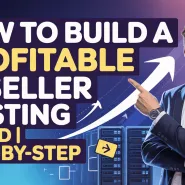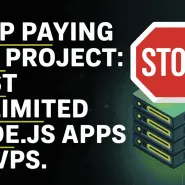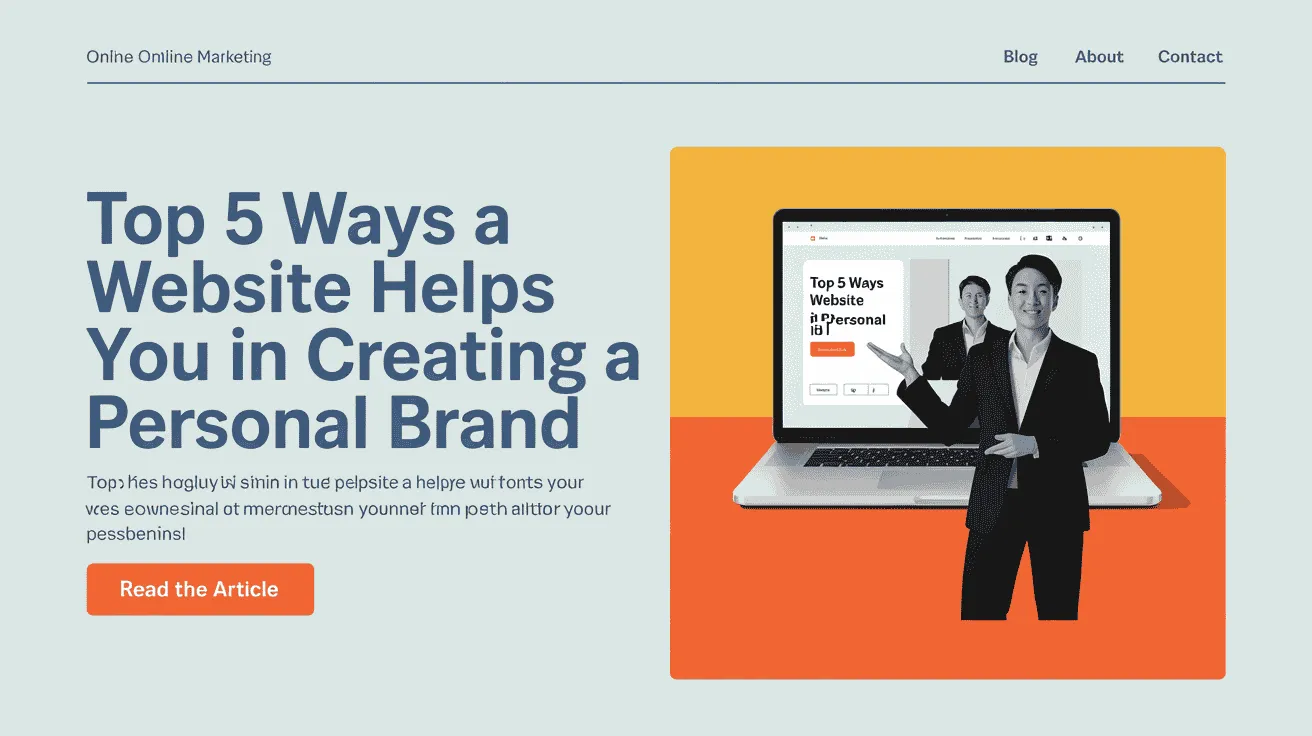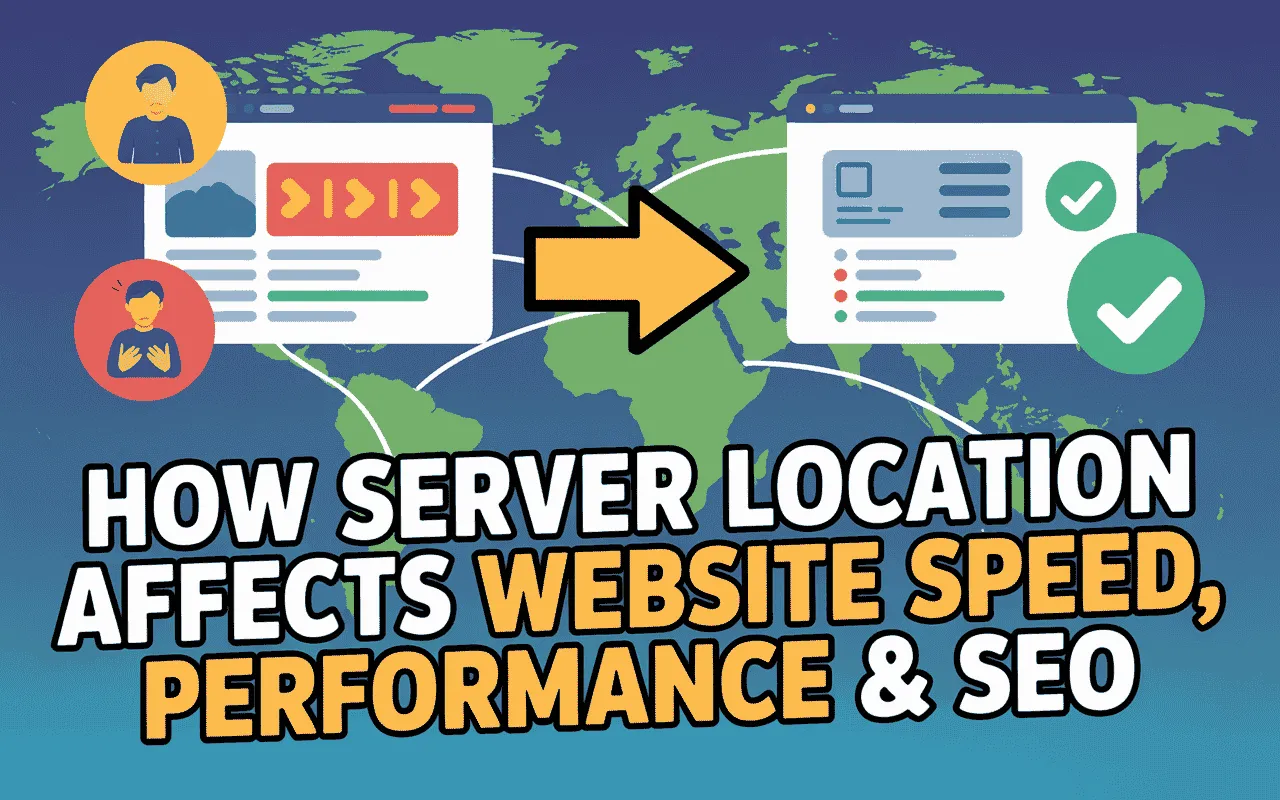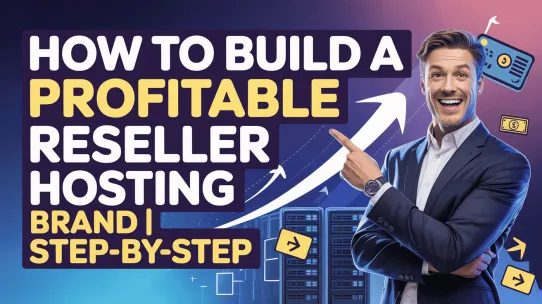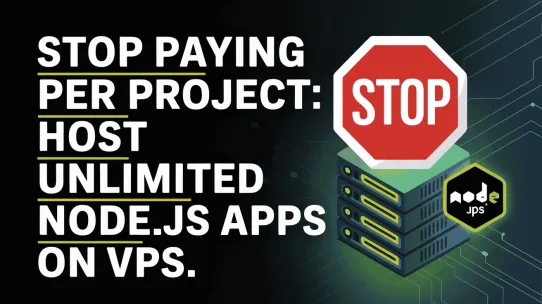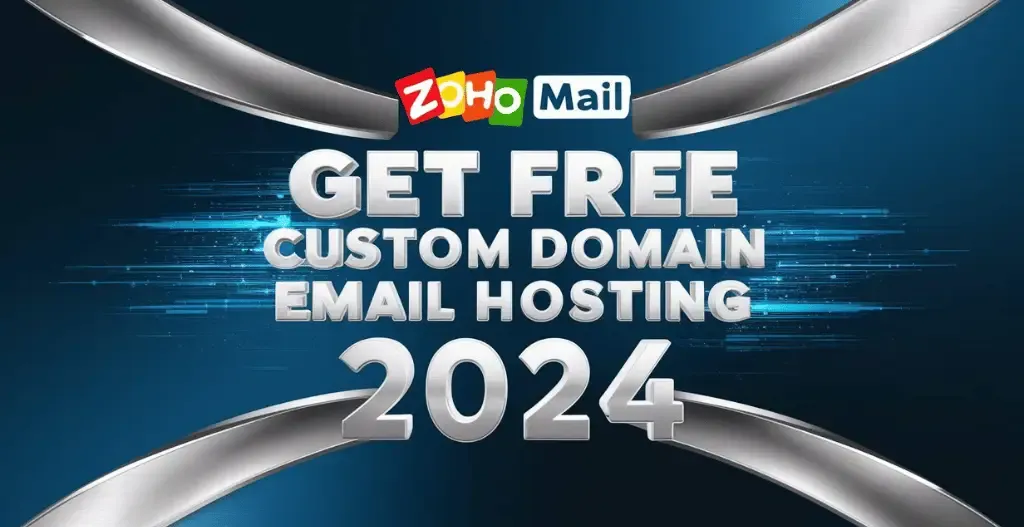Creating a personal brand is key to getting noticed. As we go through 2025, having a good presence online is a really big deal. A website is the main home for your personal brand. It’s the perfect place to show people who you are, what you’re good at, and what you believe in. Whether you have your own business, work for yourself, or are a creative person, a website is a great tool for creating a personal brand that helps you become more visible and trusted.
In this guide, we’ll talk about the top five ways a website can help you in creating a personal brand that connects with the right people. A good website makes you look professional and gives you a place to show your work. It helps you tell your own story your way. Think of it as the main spot that links all your online activities, like your social media and blog, to tell one clear story about you.
Things are always changing, and in 2025, creating a personal brand is no different. Having a website that shows off your personality and career goals is super important. It gives you control over your own story and helps you build a stronger connection with your audience. Let’s look at how you can use a website to reach more people, interact with them, and make a name for yourself in your field. Join us to learn how a well-made website can help you unlock the full power of creating a personal brand.

Introduction: The Importance of Personal Branding
Think about your favorite brand of shoes or coffee. You know what to expect from them, what they stand for, and why you choose them over others. Personal branding is the same idea, but for people. It’s the story you tell the world about who you are, what you do, and what makes you unique. The process of creating a personal brand is about carefully shaping how others see you.

In today’s world, where so much of our lives are online, creating a personal brand is more important than ever. It’s not just for celebrities or CEOs anymore; it’s for everyone. Whether you are looking for a job, starting a business, or building a network, your personal brand is what helps you stand out. It builds trust and shows people your value before they even meet you.
Ultimately, creating a personal brand gives you control over your own story. If you don’t define yourself, others will do it for you. By being intentional about the message you send, you can make a lasting and positive impression that opens up new opportunities for your career and personal growth.
Checkout Building Your Dream Website: Essential Steps with Owrbit Web Development
Way 1: Establishing Credibility and Authority
One of the biggest parts of creating a personal brand is getting people to trust you and see you as an expert. You want them to believe that you know what you’re talking about. This is what credibility and authority are all about. A website is one of the best tools to build this trust.

The Role of a Professional Website :
In the process of creating a personal brand, your website acts as your digital storefront. In 2025, it’s often the very first place people go to learn more about you. Before a meeting, a job interview, or a potential partnership, people will likely search your name online. Your website is your chance to make a perfect first impression and show them exactly what you want them to see.
One of the biggest advantages of a website is ownership. While social media platforms are important, you don’t own your profile there. The rules can change, the algorithm can hide your posts, or the platform could even lose popularity. Your website, however, is a space that you completely control. You decide the layout, the colors, and the message. This control is fundamental to creating a personal brand because it ensures your story is told your way, without any outside interference.
Having a dedicated website also signals that you are serious and professional. It shows that you have invested in yourself and your career. Think about it: an email address like [email protected] looks much more established than a generic one. This small detail adds a layer of credibility. Your website serves as a central hub, connecting all your social profiles and professional activities in one organized place, making it the solid foundation for your entire personal brand.
Showcasing Expertise Through Content :
If your website is your professional home, then the content is how you furnish it. It’s what brings your brand to life. Simply listing your skills on a resume is one thing, but showing those skills in action is far more powerful. Content is your tool for proving your expertise, and it’s a vital part of creating a personal brand that people remember and trust.
Here are a few ways you can showcase your expertise through content on your website:
- Blog Posts and Articles: Writing is one of the best ways to share what you know. You don’t need to be a professional author. Just write about topics in your field that you find interesting. For example, a marketing specialist could write a short article on the latest social media trends, or a personal trainer could share tips for a 15-minute workout. By consistently providing helpful and free information, you become a go-to resource, which builds your authority.
- Portfolio and Case Studies: This is where you show, not just tell. A portfolio is a collection of your best work. If you’re a photographer, it’s a gallery of your photos. If you’re a writer, it’s a list of your published articles. Case studies take this a step further by telling the story behind a project—what the problem was, how you solved it, and what the successful result was. This is powerful proof of your capabilities.
- Testimonials from Clients or Colleagues: Letting other people praise your work is one of the strongest ways to build credibility. A dedicated section on your website with quotes from happy clients or managers can make a huge impact. When new visitors see that others have trusted you and had a great experience, they are more likely to trust you too.
By filling your website with valuable content, you transform it from a static online business card into a dynamic platform that works for you. It actively demonstrates your knowledge and builds a strong foundation for creating a personal brand that is seen as both credible and expert in 2025.
Way 2: Creating a Unique Identity
In a crowded online space, being good at what you do is only half the battle. You also need to be memorable. Creating a unique identity is a key part of the process of creating a personal brand. It’s about developing a distinct look and feel that helps people recognize you instantly. Your website is the perfect place to build and define this identity.

Custom Branding Elements :
Custom branding elements are the visual building blocks you use to create the unique look and feel of your personal brand. Think of them as the clothes you wear or the way you decorate your home—they express your personality without you having to say a word. When someone lands on your website or social media profile, these elements are the first things they notice. Choosing them carefully is a fundamental part of creating a personal brand that is both memorable and professional.
Here are the main elements to consider:
- Logo: Your logo is your brand’s unique signature. It doesn’t have to be a complex drawing. It can be as simple as your name written in a distinctive font (this is called a logotype) or a simple icon that represents you (a logomark). This symbol will be used everywhere—on your website, your business card, and as your profile picture—so it should be clear and easy to recognize.
- Color Palette: Colors communicate feelings. The colors you choose for your brand will set the mood. For example, blues and greys can feel calm and corporate, while oranges and yellows might feel more creative and energetic. You don’t need a rainbow of colors. It’s best to pick one or two primary colors and one or two secondary colors for accents. This limited palette will make your website and other materials look clean, organized, and intentional.
- Typography: The fonts you use are just as important as your colors. Different font styles have different personalities. Some look modern and clean, while others look more traditional and formal. A good practice is to choose two fonts that work well together: one for headings and one for the main body text. This makes your content easy to read and adds to your consistent brand style.
These elements all work together to build your visual identity. Your website is the perfect place to define this style, creating a visual guide that you can use to make sure the entire effort of creating a personal brand is consistent and effective
Consistency Across Online Platforms
Once you have established the unique look and feel of your brand on your website, the next step is to apply that same identity everywhere you have a presence online. Think of it this way: if you met someone who acted like a completely different person every time you saw them, you would be confused. The same is true for your brand. Consistency is what builds recognition and trust, which are essential goals when creating a personal brand.
Here’s how to ensure your brand is consistent across different platforms:
- Your Name and Handle: Whenever possible, use the same username or “handle” on all your social media accounts, like LinkedIn, Twitter, and Instagram. This makes it incredibly easy for people to find, follow, and tag you across the web.
- Your Profile Picture: This is one of the most important elements. Use the same clear, professional headshot on every single platform. When someone sees your familiar face in a search result or a comment section, they will immediately recognize you. This visual link is powerful.
- Your Bio: While you might need to shorten it for some platforms, the core message of your bio should be the same. It should clearly state who you are, what you do, and who you help. This creates a consistent narrative about your professional identity.
- Visual Branding: Use the custom branding elements from your website on your social profiles. Upload a banner or cover photo that uses your brand’s color palette and logo. This creates a visually cohesive experience for anyone who discovers you, making your profiles look instantly more professional.
Your website acts as the “home base” for your brand identity. Your social media profiles are like satellite offices. They should all clearly belong to the same brand. By keeping your look, message, and tone consistent, you reinforce who you are in people’s minds. This simple but critical strategy turns a scattered presence into a strong, unified, and memorable personal brand in 2025.
Way 3: Enhancing Online Visibility
Having a great website is the first step, but it won’t help your personal brand if no one can find it. Enhancing your online visibility means making it easy for people to discover you when they use search engines like Google. Think of it as making sure your digital front door is on a busy street, not hidden in a back alley. A website is your most powerful tool for getting found online, which is a major goal when creating a personal brand.

SEO Best Practices for Personal Branding
Think of Search Engine Optimization (SEO) as making your website easy for Google to understand. When Google knows exactly who you are and what you do, it can confidently show your website to people who are searching for you or someone with your skills. For anyone creating a personal brand in 2025, having a basic understanding of SEO is essential. It’s how you go from having a website to having a website that gets found.
Here are some simple, practical SEO practices to focus on:
- Your Name is Your Most Important Keyword: The number one thing you want to rank for in Google is your own name. The easiest way to do this is to get a domain name that is your name (like yourname.com). You should also make sure your name is in the title of your website’s homepage and your “About” page. This sends a very strong signal to Google about who the site belongs to.
- Use Keywords That Describe What You Do: Think about the words people would type into a search bar to find a professional like you. If you are a web developer in Panipat, they might search for “website designer in Panipat” or “freelance web developer Haryana.” You should naturally include these kinds of phrases in the text on your homepage, your services page, and in your blog posts.
- Create Helpful Content: The best way to improve your SEO over time is to regularly add valuable content to your website through a blog. Each article you write that answers a common question or solves a problem for your target audience is a new opportunity to appear in search results. It shows Google that your site is a knowledgeable resource, which helps build your authority.
- Write Clear Titles and Descriptions: The title of your page is the blue link that appears in Google search results. The description is the short paragraph of text below it. Make sure every page on your site has a clear, descriptive title. For example, your “Services” page title could be “Web Development Services in Panipat | Your Name”. This helps both Google and human searchers understand what your page is about before they even click.
SEO is a long-term strategy, not a quick fix. But by consistently applying these simple practices, you build a powerful foundation that makes it easier for the right opportunities and people to find you online.
Leveraging Social Media Integration
Your website and your social media profiles should not be separate islands; they should be connected by bridges that allow people to move between them easily. Think of it like this: your social media is the bustling public place where you meet new people and have quick chats. Your website is your professional office, where you can have more detailed conversations and showcase your work. Integrating them means they work together as a team, which is a powerful strategy for creating a personal brand that feels connected and professional.
Here’s how to make that integration work effectively:
- Make Your Website the Final Destination: The most important rule is that all roads should lead back to your website. The link in your bio on Instagram, Twitter, and LinkedIn is your most valuable piece of online real estate. It should always point to your website’s homepage or a special landing page. This is because on your website, you control the experience completely—there are no distracting ads or competing posts.
- Use Social Media to Promote Your Website’s Content: Don’t just post randomly on social media. Use it as a tool to announce what’s happening on your website. When you write a new blog post, don’t just paste the text into a LinkedIn article. Instead, post an interesting highlight or a question related to the topic on LinkedIn and include a link for your followers to “read the full post on my site.” This drives traffic to your website, which is great for SEO and for showing your audience the full depth of your expertise.
- Add Social Links to Your Website: Make it easy for people who discover your website through a search engine to connect with you on other platforms. Place simple, clean icons in the header or footer of your website that link to your most important social media profiles. This allows a new visitor, who might not be ready to hire you yet, to follow you and stay updated on your work.
- Enable Easy Sharing: On your blog, include “social sharing” buttons. These are the small buttons that let a reader easily share your article with their own network on platforms like Twitter or LinkedIn. When someone shares your content, they are giving you a personal recommendation, which can introduce your personal brand to a whole new audience.
By creating this two-way street between your website and your social media, you build a stronger and more visible online presence. This interconnected system ensures that no matter how someone discovers you in 2025, they can easily find everything you have to offer.
Way 4: Connecting with Your Audience
Creating a personal brand is not just about broadcasting your message out to the world; it’s about building a genuine connection with the people who are interested in what you do. A successful brand has a community around it. Your website is the perfect place to turn passive viewers into an active audience by making it easy for them to talk to you and stay in touch.

Building an Email List :
While having followers on social media is good, building an email list is even better. Think of it this way: your social media profile is like a rented space. The platform owns the property and can change the rules at any time. Your email list, on the other hand, is a communication channel that you own completely. It’s a direct line to your most interested followers, making it one of the most powerful tools for creating a personal brand with a loyal community.
Here’s a simple process for getting started:
- 1. Offer Something Valuable for Free
- People are protective of their email inboxes. To get them to subscribe, you need to offer them something genuinely useful in return. This free gift is often called a “lead magnet.” It doesn’t have to be complicated. It could be:
- A simple PDF checklist (e.g., “10 Things Your Small Business Website Needs in 2025”).
- A short guide (e.g., “A Quick Guide to Local SEO for Businesses in Mumbai”).
- A helpful template or a video tutorial.
- The goal is to provide a solution to a problem your ideal audience might have.
- People are protective of their email inboxes. To get them to subscribe, you need to offer them something genuinely useful in return. This free gift is often called a “lead magnet.” It doesn’t have to be complicated. It could be:
- 2. Make It Easy to Sign Up
- Once you have your free offer, you need to place simple sign-up forms on your website where people can easily see them. Good places include:
- On your homepage, with a clear call to action.
- At the end of every blog post.
- In the footer of your website.
- The form itself should be simple, asking only for a first name and an email address. The easier you make it, the more likely people are to subscribe.
- Once you have your free offer, you need to place simple sign-up forms on your website where people can easily see them. Good places include:
- 3. Build the Relationship
- Once someone joins your list, the focus is on providing value, not just selling. Your first email should automatically welcome them and deliver the free resource they signed up for. After that, you can send a newsletter, perhaps once a month, with helpful tips, links to your latest articles, or exclusive content that you don’t share anywhere else. The key is to be consistent and respectful of their inbox.
By building an email list, you are creating a community of people who want to hear from you. This direct connection is essential for turning followers into true supporters of your personal brand.
Utilizing Contact Forms and Chatbots
A contact form is the most basic and essential way to let people get in touch. It’s more professional and secure than just listing your email address, as it helps protect you from spam and keeps your inquiries organized.
Here are a few tips for a great contact form:
- Keep it Simple: The biggest mistake is asking for too much information. Every extra field you add makes it less likely that someone will complete the form. Stick to the absolute essentials: Name, Email, and Message.
- Set Expectations: After someone clicks “submit,” don’t just leave them on a blank page. Show a confirmation message like, “Thank you for your message! I’ll get back to you within one business day.” This is polite and lets them know their inquiry was successful.
- Make it Easy to Find: Your contact form should be on a dedicated “Contact” page that is clearly visible in your website’s main menu.
Chatbots: Your 24/7 Assistant
In 2025, people often want immediate answers. A chatbot is a small, automated chat window on your website that can help visitors instantly, even if you’re not at your desk. It’s like having a helpful receptionist who works around the clock.
You can use a simple chatbot for things like:
- Answering Frequently Asked Questions: You can program it to automatically answer the questions you get most often, such as “What services do you offer?” or “Are you based in Mumbai?”.
- Guiding Visitors: A chatbot can ask a few simple questions to help a visitor find the right information on your site.
- Taking a Message: If a visitor has a specific question the bot can’t answer, it can collect their name and email address and let them know you’ll be in touch personally.
Even a simple chatbot makes your personal brand feel modern and highly responsive, improving a visitor’s experience and showing that you value their time.
Way 5: Showcasing Your Work and Achievements
Everything else we have discussed—from your brand identity to your SEO—helps to build the frame. This final step is about the masterpiece that goes inside it: your actual work. This is where you provide the proof that you can do what you say you can do. Showcasing your accomplishments and positive feedback is perhaps the most important part of creating a personal brand because it turns your claims into facts.

Portfolio and Case Studies
This is the part of your website where you stop talking about your skills and start proving them. A strong portfolio or a well-written case study can be the most persuasive element of your entire personal brand. It’s the concrete evidence that shows potential clients exactly what you are capable of achieving.
The Portfolio: A Gallery of Your Best Work
Think of your portfolio as a “greatest hits” collection. It is not meant to be a list of every project you have ever worked on. Instead, it should be a curated selection of your very best work—the projects that make you proud and best represent the kind of work you want to do more of.
For each project in your portfolio, you should include:
- A strong visual, like a high-quality photo, screenshot, or video.
- A clear title for the project.
- A short, one-or-two-sentence description of what you did.
- A link to the live project if possible, so people can see it in action.
The goal of a portfolio is to quickly impress a visitor with the quality and style of your work. It’s a visual handshake that says, “Here is the caliber of work I produce.”
The Case Study: The Story of a Successful Project
A case study goes much deeper than a portfolio piece. It tells the story behind the work, which is often more compelling than the work itself. It shows a potential client that you don’t just have technical skills; you have strategic thinking skills and can deliver real results.
A simple but effective case study follows a three-part story structure:
- The Problem: Start by describing the challenge your client was facing. For example, “A local retailer in Panipat was struggling to sell their products online.”
- Your Solution: Next, explain the specific steps you took to solve that problem. For example, “I built a user-friendly e-commerce website, optimized their product photos, and set up a simple payment system.”
- The Result: This is the most important part. Share the positive outcome, using specific numbers if you can. For example, “After the new website launched, their online sales increased by 60% in the first quarter.”
While a portfolio shows what you can do, a case study shows the value of what you do. Including both on your website is a powerful strategy for creating a personal brand that builds trust and wins clients in 2025.
Testimonials and Reviews
Think about how you decide where to eat in Panipat or what to buy online. You probably look at the reviews first. Testimonials are the professional equivalent of those five-star reviews, and they are one of the most persuasive tools you have. People will always trust what a past client says about you more than what you say about yourself. This is called “social proof,” and it is essential for creating a personal brand that feels credible and trustworthy.
How to Ask for a Testimonial
The best time to ask for a review is right after you’ve finished a project and your client is happy with the result. People are often willing to help, but you can make it easier for them. Instead of just asking them to “write a testimonial,” which can feel like a difficult task, send them a friendly email with a few guiding questions, such as:
- What was the biggest challenge you had before we started working together?
- What was the best part of the process of working with me?
- What specific result or outcome did our work achieve for you?
These questions help them structure their thoughts and often result in a much more specific and powerful testimonial. Always remember to ask for their permission to use their name, title, and company on your website.
What Makes a Great Testimonial
A generic comment like “He did a great job” is nice, but it doesn’t have much impact. The most effective testimonials are specific and show a real result. Compare these two:
- Good: “Om was great to work with.”
- Excellent: “Working with Om was a fantastic experience. The new website he built for us led to a 40% increase in customer inquiries in just two months. He delivered everything on schedule and was a true professional.”
The second one is far more convincing because it highlights a tangible business result. To make testimonials even more credible, always try to include the person’s full name, their job title, and their company (for example, “Sunita Sharma, Owner, Sharma Handicrafts, Panipat”).
Where to Put Them on Your Website
Don’t just hide all your great reviews on a single testimonials page. Sprinkle them strategically throughout your website to build trust at every step. You can place a powerful quote on your homepage, put a relevant testimonial next to each service you offer, and feature a client’s feedback right beside the project you completed for them in your portfolio. This way, no matter where a visitor is on your site, they will see proof of your excellent work.
Conclusion: The Ongoing Journey of Personal Branding
As we’ve explored, creating a personal brand in 2025 is a powerful way to shape your professional destiny, and your website is the cornerstone of that effort. It is far more than just an online resume; it is your digital home base where you can establish your credibility, define your unique identity, and increase your visibility to the world. It provides the tools to connect with an audience and the space to showcase clear proof of your skills and accomplishments.
But it’s important to remember that this work is never truly “finished.” Creating a personal brand is not a one-time task but an ongoing journey. Think of it like tending a garden; it requires continuous care and attention. Your website should grow and evolve with you. As you gain new skills, complete new projects, and reach new milestones in your career, your website should be updated to reflect that growth.
Your personal brand is the story of your professional life. By taking control of that story and giving it a home on a well-crafted website, you are no longer just waiting for opportunities to find you. You are actively creating them. The journey is a marathon, not a sprint, but with a strong website as your foundation, you are building a brand that can support your ambitions for years to come.
Discover more from Owrbit
Subscribe to get the latest posts sent to your email.

